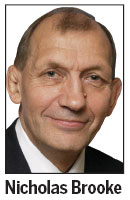Internet of Things - the next step to a smarter world
Updated: 2013-05-25 06:11
By Nicholas Brooke(HK Edition)
|
|||||||||
While the Internet has transformed the world, getting people connected and opening the gates to a flood of information, the inevitable question now is: What's next? Such a query creates another: What more do you want the Internet to do for you? With technology having helped link people closer together, the obvious progress would now appear to be bringing "things" together as well.
The connection of objects to the Internet, better known as the Internet of Things (IoT), a name coined by Briton Kevin Ashton back in 1999, can involve such mundane devices as toasters and coffee pots or more significant technologies such as power meters in smart buildings and sensors for the human body. The data collected can subsequently be processed and manipulated using smart devices to prepare the perfect breakfast each morning or, more importantly, promote greater efficiency and enhanced well-being.

The importance of IoT has not been lost on the Chinese central government, as the former premier Wen Jiabao stated back in 2009 that China would be committed to sensor technologies and cloud computing going forward.
Already, the world is moving towards the IoT era, driven by the ubiquity of smart devices, increasing adoption of cloud computing, proliferation of radio frequency identification (RFID) and big data analytics, among other stimuli.
Right here in Hong Kong, where people have traditionally been highly receptive to new technology, many have relied on RFID for years, even if they may be unaware of it. Since its official introduction in 1997, the Octopus card has become an essential companion of Hong Kong people, with a circulation of more than 22 million and responsible for more than 12 million transactions each day. RFID has also been used in such applications as baggage handling - Hong Kong International Airport being the first airport to efficiently use UHF Gen2 tags in this application - and for collecting tolls at all 12 tollways throughout Hong Kong. In the future, information collected from RFID could be used to improve human and traffic flow, conserve energy and reduce pollution.
To better promote IoT and its far-reaching benefits, the Hong Kong Internet of Things Center of Excellence recently soft opened at Hong Kong Science Park. Spearheaded by GS1 Hong Kong, a non-profit industry support organization, and with principal backing from the SAR government via the Innovation and Technology Commission and Science Park, the center consists of five zones - manufacturing, logistics, healthcare, retail and smart city. Each zone contains displays that highlight IoT-related technologies, allowing visitors to better appreciate IoT in respective scenarios. The center will also help demonstrate the use of technologies such as RFID, Near Field Communication and Quick Response codes, which are already having a positive impact on business processes.
While the IoT promises much, and many of the technologies are already in existence, the lack of adequate infrastructure is currently its Achilles' heel. Smart grids and utilities require time to be constructed if the concept is to come to fruition. Once again, this will necessitate support from the public and private sectors, as well as a fair amount of commitment from both sides. Where all of these elements are present, however, Internet of Things could well develop as far as our imaginations can take us.
The author is chairman of the Hong Kong Science & Technology Parks Corporation.
(HK Edition 05/25/2013 page6)